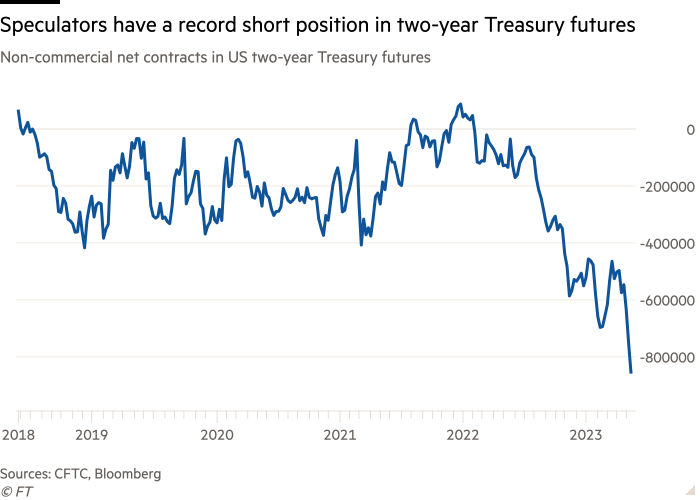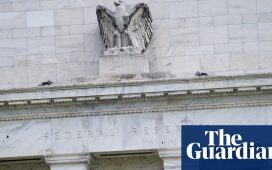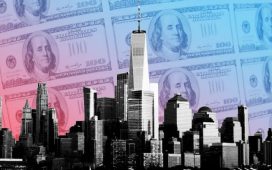This article is an on-site version of our Unhedged newsletter. Sign up here to get the newsletter sent straight to your inbox every weekday
Good morning. Kate here. Thanks so much for having me back at Unhedged while Ethan and Rob are off. It was lovely hearing from you last time, and I’d be keen to get your thoughts again today, especially about debt ceiling risks that you think aren’t getting enough attention. Email me: kate.duguid@ft.com.
What happens after the debt ceiling deal?
Lawmakers in Washington are negotiating a deal to raise the debt ceiling. Republican House Speaker Kevin McCarthy has met President Joe Biden this week, and Federal Reserve chair Jay Powell has weighed in too. At stake is a US debt default, which may happen if a deal is not reached by June 1.
The exact contours of a deal will matter to markets. But I’m also curious about what happens after a resolution is reached. Suppose that in a week Congress has raised the debt ceiling and averted a US default. What then?
The US reached its $31.4tn borrowing limit back in January, and has since been using “extraordinary measures” (ie, digging spare change out of the couch cushions) to pay its bills. So as soon as a deal is reached, a lot of money will need to be borrowed to replenish the Treasury department’s coffers. Jay Barry, co-head of US rates strategy at JPMorgan (who cleverly titled his note on the topic “Après moi, le déluge”), has said its estimates are for Treasury to issue about $750bn in bills in the four months following a resolution, with roughly $1.1tn in the last seven months of 2023.
Someone has to pay in cash for all those fresh Treasuries, sucking liquidity out of the system. Analysts say that this flood of issuance could add strain to banks and raise borrowing costs as the US economy continues to slow.
Quantitative tightening has already led to a huge amount of cash pulled out of bank reserves. A flood of Treasury bills could exacerbate that drain, enough that it may force the Fed to question whether it can maintain QT, Barry says.
The pain isn’t limited to the bond market. A debt deal will probably involve cuts in government spending that could curtail economic growth and hit stocks, says Jake Jolly, head of investment analysis at BNY Mellon.
“There seems to be a view out there that there will be a relief rally on the deal. I think that is a huge mistake. That didn’t happen in 2011. The austerity that came with that deal was more than what the market expected. Today, my concern is that while no debt ceiling debate is exactly the same as the previous, this one could more adversely affect markets.”
The constraint on liquidity in the market from the surge in T-bill issuance is also likely a risk for stocks. Michael Wilson, equity strategist at Morgan Stanley, over the weekend warned that “while a debt ceiling resolution removes a near-term market risk, a material dislocation was never priced in and the bigger risk for markets now is that raising the debt ceiling could decrease market liquidity based on the sizeable Treasury issuance we expect over the six months after it passes”. In other words, even an orderly end to the debt ceiling drama could hurt.
Money market funds — mutual funds that invest in short-term debt — could help cushion the blow by absorbing some of this supply.
Money market funds have typically had a huge portion of their holdings in Treasury bills, but that proportion has changed in the past two years as money funds have increasingly come to rely on the Fed’s reverse repo facility. This programme — which lets certain investors stash cash there overnight — has attracted big inflows since 2021 because it offers generous returns for no risk. Some $2.3tn is stashed in the RRP every night.
A flood of T-bill supply should mean lower prices and higher yields, making bills more competitive with the RRP for money market funds, which have lots of cash to put to work.
While this should help, the quantities of debt to be issued are vast, and may ultimately require a Fed-shaped intervention like, perhaps, the end of QT.
Shorts season
Speculative traders like hedge funds have the biggest short position in two-year Treasury futures on record. You can see the position in the weekly data released by the Commodity Futures Trading Commission charted below:

If this were a straightforward short position, it would be a way of betting on a rise in two-year yields and a drop in price. Because two-year yields move with interest rate expectations, that would suggest speculators were betting either on more interest rate increases from the Fed or on higher rates for longer.
The CFTC’s data is an aggregate and certainly captures some traders who are making that bet. But investors and analysts cautioned that a bulk of the position is likely part of a relative value trade, paired with a long position in cash, which profits from dislocations between the price of comparable securities in the futures and cash markets. It is a bet on pricing quirks, not rates fundamentals.
The head of rates trading at a big US hedge fund, who wasn’t able to speak on the record, said: “I think what you’re seeing in the hedge fund numbers is not a directional bet but a relative value bet . . . It is relative value strategies — in the dealer and prop community as well as hedge funds — essentially being short the futures and long cash.”
Shorting two-year Treasuries has been a painful trade this year. Speculators were at record shorts in two-year futures right before the collapse of Silicon Valley and Signature banks. The turmoil at those banks then prompted investors to buy two-year Treasuries, betting that the Fed would be forced to cut interest rates — and seeking safety in the haven Treasury market. The shift into two-year notes caught out hedge funds who were short, and forced them to exit those positions, creating huge amounts of volatility in the market. The swings in price were big enough to prompt concern from regulators.
As Ethan and Rob often say, the peak of the tightening cycle is often when things in markets break. That makes this a risky time to be in a big short position in a part of the market that attracts investors during moments of turmoil, both for its safe-haven quality, and because it’s the place to express views on the Fed’s next move.
The other shorts season
Rob has mentioned wearing shorts in passing in his fashion columns, but has never addressed the topic head-on. (Coward.) Here, then, from the FT archives is a piece on whether you can wear shorts to the office.









